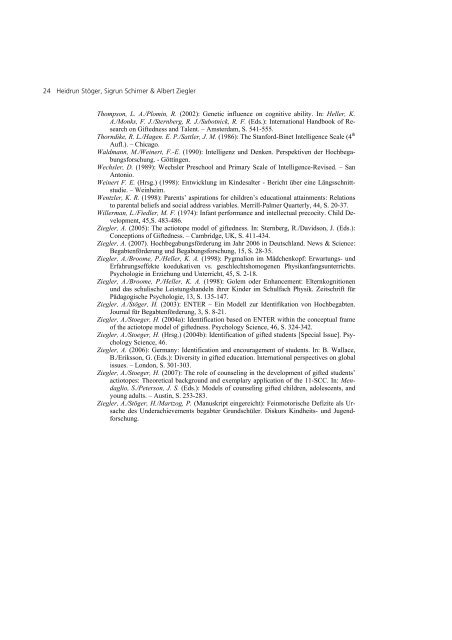Ist die Identifikation Begabter schon im Vorschulalter möglich? Ein ...
Ist die Identifikation Begabter schon im Vorschulalter möglich? Ein ...
Ist die Identifikation Begabter schon im Vorschulalter möglich? Ein ...
Sie wollen auch ein ePaper? Erhöhen Sie die Reichweite Ihrer Titel.
YUMPU macht aus Druck-PDFs automatisch weboptimierte ePaper, die Google liebt.
24 Heidrun Stöger, Sigrun Schirner & Albert Ziegler<br />
Thompson, L. A./Plomin, R. (2002): Genetic influence on cognitive ability. In: Heller, K.<br />
A./Monks, F. J./Sternberg, R. J./Subotnick, R. F. (Eds.): International Handbook of Research<br />
on Giftedness and Talent. – Amsterdam, S. 541-555.<br />
Thorndike, R. L./Hagen. E. P./Sattler, J. M. (1986): The Stanford-Binet Intelligence Scale (4 th<br />
Aufl.). – Chicago.<br />
Waldmann, M./Weinert, F.-E. (1990): Intelligenz und Denken. Perspektiven der Hochbegabungsforschung.<br />
- Göttingen.<br />
Wechsler, D. (1989): Wechsler Preschool and Pr<strong>im</strong>ary Scale of Intelligence-Revised. – San<br />
Antonio.<br />
Weinert F. E. (Hrsg.) (1998): Entwicklung <strong>im</strong> Kindesalter - Bericht über eine Längsschnittstu<strong>die</strong>.<br />
– Weinhe<strong>im</strong>.<br />
Wentzler, K. R. (1998): Parents’ aspirations for children’s educational attainments: Relations<br />
to parental beliefs and social address variables. Merrill-Palmer Quarterly, 44, S. 20-37.<br />
Willerman, L./Fiedler, M. F. (1974): Infant performance and intellectual precocity. Child Development,<br />
45,S. 483-486.<br />
Ziegler, A. (2005): The actiotope model of giftedness. In: Sternberg, R./Davidson, J. (Eds.):<br />
Conceptions of Giftedness. – Cambridge, UK, S. 411-434.<br />
Ziegler, A. (2007). Hochbegabungsförderung <strong>im</strong> Jahr 2006 in Deutschland. News & Science:<br />
Begabtenförderung und Begabungsforschung, 15, S. 28-35.<br />
Ziegler, A./Broome, P./Heller, K. A. (1998): Pygmalion <strong>im</strong> Mädchenkopf: Erwartungs- und<br />
Erfahrungseffekte koedukativen vs. geschlechtshomogenen Physikanfangsunterrichts.<br />
Psychologie in Erziehung und Unterricht, 45, S. 2-18.<br />
Ziegler, A./Broome, P./Heller, K. A. (1998): Golem oder Enhancement: Elternkognitionen<br />
und das schulische Leistungshandeln ihrer Kinder <strong>im</strong> Schulfach Physik. Zeitschrift für<br />
Pädagogische Psychologie, 13, S. 135-147.<br />
Ziegler, A./Stöger, H. (2003): ENTER – <strong>Ein</strong> Modell zur <strong>Identifikation</strong> von Hochbegabten.<br />
Journal für Begabtenförderung, 3, S. 8-21.<br />
Ziegler, A./Stoeger, H. (2004a): Identification based on ENTER within the conceptual frame<br />
of the actiotope model of giftedness. Psychology Science, 46, S. 324-342.<br />
Ziegler, A./Stoeger, H. (Hrsg.) (2004b): Identification of gifted students [Special Issue]. Psychology<br />
Science, 46.<br />
Ziegler, A. (2006): Germany: Identification and encouragement of students. In: B. Wallace,<br />
B./Eriksson, G. (Eds.): Diversity in gifted education. International perspectives on global<br />
issues. – London, S. 301-303.<br />
Ziegler, A./Stoeger, H. (2007): The role of counseling in the development of gifted students’<br />
actiotopes: Theoretical background and exemplary application of the 11-SCC. In: Mendaglio,<br />
S./Peterson, J. S. (Eds.): Models of counseling gifted children, adolescents, and<br />
young adults. – Austin, S. 253-283.<br />
Ziegler, A./Stöger, H./Martzog, P. (Manuskript eingereicht): Feinmotorische Defizite als Ursache<br />
des Underachievements begabter Grundschüler. Diskurs Kindheits- und Jugendforschung.


